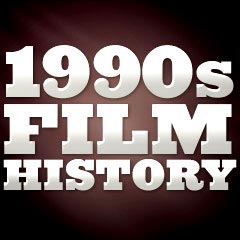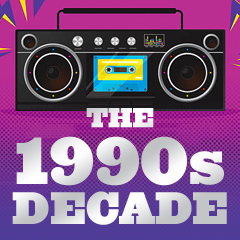|
James Bond Films in the 90s:
Not unexpectedly, Agent 007 James Bond films flourished
in the 90s (all with Pierce Brosnan), although there was a six year gap
between the 16th film, Licence to Kill (1989) and the next Bond
film, due, in part, to prolonged litigation over rights to the James Bond
character stretching back 40 years. [The conflict was between Kevin McClory,
a producer and coscreenwriter of Thunderball (1965), who attempted
to claim a piece of MGM's $1 billion James Bond franchise by specifically
asserting, in 1997, that he was co-owner of the Bond character. The case,
between MGM/UA and Sony, was finally settled by the courts in the late
1990s]:
-
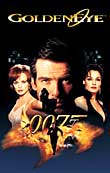 GoldenEye
(1995), the 17th James Bond thriller from first-time Bond director
Martin Campbell; the most lucrative of the series' films and noted for
the first appearance of Pierce Brosnan as 007 (in Bond's 5th incarnation);
also starred Izabella Scorupco and Famke Janssen as the 'Bond Girls'
and Sean Bean as the villain (Alec Trevelyan) GoldenEye
(1995), the 17th James Bond thriller from first-time Bond director
Martin Campbell; the most lucrative of the series' films and noted for
the first appearance of Pierce Brosnan as 007 (in Bond's 5th incarnation);
also starred Izabella Scorupco and Famke Janssen as the 'Bond Girls'
and Sean Bean as the villain (Alec Trevelyan)
- Tomorrow Never Dies (1997) - the 18th official
Bond film in the series, with Pierce Brosnan against a crazed, manipulative
megalomaniac Jonathan Pryce; Michelle Yeoh and Teri Hatcher starred
as 'Bond Girls'
- The World is Not Enough (1999) - the 19th official
entry and director Michael Apted's first Bond film; starring Sophie
Marceau as Elektra King, and Denise Richards as Dr. Christmas Jones
- Die Another Day (2002) - the 20th Bond film
and Brosnan's fourth film; starring Halle Berry as Jinx; directed by
Lee Tamahori
Major Blockbusters: Phenomenal Successes
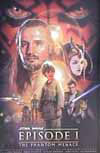 Since
the making of Jaws (1975), studio executives
were primed toward making blockbusters to meet the bottom line. In the
90s, many of the greatest box-office hits of all time (in the top
twenty) were made and marketed with sophisticated publicity and merchandising
campaigns: Since
the making of Jaws (1975), studio executives
were primed toward making blockbusters to meet the bottom line. In the
90s, many of the greatest box-office hits of all time (in the top
twenty) were made and marketed with sophisticated publicity and merchandising
campaigns:
- Steven Spielberg's and Universal's f/x laden Jurassic
Park (1993) (based upon Michael Crichton's 1990 novel) with photo-realistic,
computer-generated dinosaurs spliced into live-action sequences, i.e.,
the car-crunching T-Rex sequence
- Adrian Lyne's Indecent Proposal
(1993), in which wealthy Robert Redford offered
one million dollars as the price-tag for one night with married Demi
Moore
- Chris Columbus' Mrs. Doubtfire (1993)
- Robert Zemeckis' Forrest Gump (1994)
- The Lion King (1994)
- the apocalyptic disaster film ("Earth! Take a
good look. It could be your last") from director Roland Emmerich
Independence Day (1996) - that set a record by grossing $100
million in box-office receipts during its first six days, and won a
Best Visual Effects Oscar - mostly for the sequence of the White House
exploding
- Twister (1996) - about the chasing of tornadoes
by researcher Bill Harding (Bill Paxton) while trying to divorce his
wife Jo (Helen Hunt)
- Titanic (1997) - see below
- Men in Black (1997) - with Tommy Lee Jones and
Will Smith as black-clad buddies on a mission
- Spielberg's sequel The Lost World: Jurassic Park
(1997)
- Michael Bay's top-grossing, but expensive-to-make Armageddon
(1998) from Touchstone (a Disney Company)
- Star Wars: Episode I - The Phantom Menace (1999) - a box-office success although derisively criticized by fans and
other reviewers as shallow story-telling but with dazzling visual effects
- The Mummy (1999), a glossy remake of the original,
with French Foreign legion hero Brendan Fraser stumbling upon an ancient
city in Egypt and awakening high priest Imhotep
- Toy Story 2 (1999) - a sequel that far surpassed
the original Toy Story (1995) in terms of the quality of animation,
voice acting and script, as the themes from the first film -- obsolescence
and loyalty -- were explored even more deeply. It was also a major
financial success, and the third highest-ranking film of the year
in terms of box-office revenue (at $245.8 million domestic).
 But
the biggest box-office ($294 million) and critics favorite - and psychological
thriller - was writer/director M. Night Shyamalan's The Sixth Sense
(1999) - about a 9 year-old boy (Haley Joel Osment) who saw ghosts
of dead people (with the memorable tagline "I see dead people")
all around south Philadelphia, and who shared his ghostly experience with
child psychologist Bruce Willis. The mysterious film from an unknown director
generated much talk over its unexpected twist ending. [There were at least
five films famous for their gripping twist or surprise endings in this
decade: The Crying Game (1992), Se7en (1995), The Usual
Suspects (1995), and Fight Club (1999) could be added.] But
the biggest box-office ($294 million) and critics favorite - and psychological
thriller - was writer/director M. Night Shyamalan's The Sixth Sense
(1999) - about a 9 year-old boy (Haley Joel Osment) who saw ghosts
of dead people (with the memorable tagline "I see dead people")
all around south Philadelphia, and who shared his ghostly experience with
child psychologist Bruce Willis. The mysterious film from an unknown director
generated much talk over its unexpected twist ending. [There were at least
five films famous for their gripping twist or surprise endings in this
decade: The Crying Game (1992), Se7en (1995), The Usual
Suspects (1995), and Fight Club (1999) could be added.]
Hollywood was relieved (and recouped its costs) when
its traditional kind of blockbuster did well in the summer of 1991, evidenced
by James Cameron's expensive sequel Terminator
2: Judgment Day (1991). It featured superstar Arnold Schwarzenegger
("Hasta la vista, baby!") as a T-800 cyborg, and incredible,
quicksilver "morphing" effects of the opposing, molten-metal T-1000 android
(Robert Patrick) produced with high-powered Silicon Graphics super-computers).
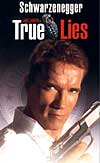 It was the first film with a $100 million budget. [Cameron had written
and directed the earlier low-budget The Terminator
(1984) with modest success. Likewise, he had transformed Ridley
Scott's Alien (1979) into a big-budget
sequel titled Aliens (1986).] It was the first film with a $100 million budget. [Cameron had written
and directed the earlier low-budget The Terminator
(1984) with modest success. Likewise, he had transformed Ridley
Scott's Alien (1979) into a big-budget
sequel titled Aliens (1986).]
Writer/director
Cameron's next film (with secret agent Arnold Schwarzenegger as Harry)
was True Lies (1994) - a Bond-like spy-adventure packed with special
effects, thrills, an exciting jet and car chase over the Florida Keys,
and tongue-in-cheek comedy about how Harry's wife Helen (Jamie Lee Curtis)
didn't know his occupation. [It was the first movie with a budget to exceed $100 million, and eventually grossed $365 million.] Ridley Scott closed the decade with the Best
Picture, multiple-Oscar winner Gladiator (2000), a computer-enhanced
Roman Empire sandals-toga epic with Australian actor Russell Crowe as
the virtuous and wronged Maximus who sought revenge in the Coliseum.
The Phenomenon of Titanic:
 Writer/director
James Cameron solidified his reputation as the undisputed king of mega-blockbusters
in this decade with his studio-shared (Fox and Paramount) Titanic (1997)
(grossing $600 million in the US alone, and $1.8 billion worldwide for
the studios). It was the first film with a budget exceeding $200 million. Titanic retold the spectacular, epic-disaster of
the 1912 ill-fated, maiden voyage cruise of the R.M.S. Titanic,
when it was pierced by an iceberg. The tense scene of the sinking of the
ship was created with state-of-the-art digital effects and a life-size
version of the ship. In addition, a secondary love story between star-crossed
lovers - poor passenger Jack Dawson (Leonardo DiCaprio) and upper-class
Rose DeWitt Bukater (Kate Winslet), told in flashback by an older Rose
(Gloria Stuart) slowly built to the inevitable conclusion. Writer/director
James Cameron solidified his reputation as the undisputed king of mega-blockbusters
in this decade with his studio-shared (Fox and Paramount) Titanic (1997)
(grossing $600 million in the US alone, and $1.8 billion worldwide for
the studios). It was the first film with a budget exceeding $200 million. Titanic retold the spectacular, epic-disaster of
the 1912 ill-fated, maiden voyage cruise of the R.M.S. Titanic,
when it was pierced by an iceberg. The tense scene of the sinking of the
ship was created with state-of-the-art digital effects and a life-size
version of the ship. In addition, a secondary love story between star-crossed
lovers - poor passenger Jack Dawson (Leonardo DiCaprio) and upper-class
Rose DeWitt Bukater (Kate Winslet), told in flashback by an older Rose
(Gloria Stuart) slowly built to the inevitable conclusion.
The melodramatic film was notable for many milestones:
- it became the highest grossing and most successful
film of all time (passing the megahit of the past Gone with the Wind (1939))
- its worldwide gross was $1.835 billion, and it was the first movie to gross $1 billion
- it was the most expensive film in Hollywood history
estimated at about $200 million
- it tied Ben-Hur (1959)
with its eleven Oscar wins
It also featured Celine Dion's popular song: 'My Heart
Will Go On.' The mega-hit even surpassed Steven Spielberg's box-office
blockbusters: Jurassic Park (1993) and E.T.:
The Extra-Terrestrial (1982).
Minor Films Were Also Successful:
Other successful films were small, comparatively cheap, and often independently-produced
films that unpredictably soared at the box office:
- director Frank Marshall's Arachnophobia (1990)
told about a threatening lethal spider/creature that made its way to
California from Venezuela; it starred John Goodman as the town exterminator,
and Jeff Daniels as a doctor afraid of spiders
- director Chris Columbus' blockbuster Home Alone
(1990) and scripted by John Hughes - was one of the most lucrative
comedies ever made, with new child star Macaulay Culkin as an
8 year-old boy accidentally left behind when his parents fly off to
Paris for Christmas vacation and foiling robbers Harry and Marv (Joe
Pesci and Daniel Stern); it was followed by a less-successful sequel
Home Alone 2: Lost in New York (1992) with the same slapstick
gimmicks
 director Garry Marshall's call-girl fantasy romance
Pretty Woman (1990) (released by Disney Studios - its highest
grossing release up to that time), sent sweetheart superstar Julia Roberts
catapulting to fame in the Disney-fied Cinderella-like story
of a Hollywood Boulevard streetwalker's (Vivian Ward) transformation
while spending a week (for $3000) with silver-haired Wall Street millionaire
Richard Gere (as Edward Lewis) at the Regent Beverly Wilshire Hotel director Garry Marshall's call-girl fantasy romance
Pretty Woman (1990) (released by Disney Studios - its highest
grossing release up to that time), sent sweetheart superstar Julia Roberts
catapulting to fame in the Disney-fied Cinderella-like story
of a Hollywood Boulevard streetwalker's (Vivian Ward) transformation
while spending a week (for $3000) with silver-haired Wall Street millionaire
Richard Gere (as Edward Lewis) at the Regent Beverly Wilshire Hotel- comedy director Jerry Zucker's supernatural, tearjerker love story Ghost
(1990) starred Demi Moore and Patrick Swayze as passionate lovers
separated by tragedy but brought together by psychic spirit medium Whoopi
Goldberg (a Best Supporting Actress Oscar winning role); the film revived
the Righteous Brothers' 60s hit "Unchained Melody"
- The Bodyguard (1992) was one of the top-grossing
films of its year, with Kevin Costner as a Secret Service agent hired
to protect a musical superstar (Whitney Houston in her acting debut)
- screenwriter Frank Darabont's directorial debut film
that was narrated by lifer inmate 30265 (Morgan Freeman), The
Shawshank Redemption (1994), was the first of his two 'life-affirming'
prison dramas in the decade that were both adapted from works of horror
writer Stephen King. [Although it suffered poor numbers at the box-office,
its enormous success came after video release, and it became a sleeper
hit through word-of-mouth.]
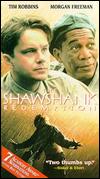 the Australian film Muriel's Wedding (1994)
was a sleeper hit that starred Toni Collette as an unconventional woman
who felt unloved and worthless, so she moved from the small town of
Porpoise Spit to Sydney in search of the perfect man to marry the Australian film Muriel's Wedding (1994)
was a sleeper hit that starred Toni Collette as an unconventional woman
who felt unloved and worthless, so she moved from the small town of
Porpoise Spit to Sydney in search of the perfect man to marry- Italy's Il Postino (The Postman) (1995) was
the first foreign-language film since 1973 to be nominated for
Best Picture
- Clint Eastwood acted and directed The Bridges of
Madison County (1995), portraying a National Geographic photographer
who entered into a middle-aged love affair with housewife Meryl Streep
- another serial killer crime drama
of the decade - David Fincher's unflinching police thriller Se7en
(1995) followed two detectives (retiring cop Morgan Freeman and
rookie cop Brad Pitt) in pursuit of a maniacal psychopath who dramatized
the seven deadly sins (gluttony, greed, sloth, pride, lust, envy, and
wrath) of the works of Chaucer and Dante with gruesome murders; the film's gruesome ending (a head-in-a-box) was controversial, but didn't deter the film from garnering over $300 million in worldwide box-office receipts
- actor/director/writer Roberto Benigni's sentimental
Italian, WWII comedy-drama Life is Beautiful (1998) was the most
successful sub-titled, imported foreign-language film of all time -
a mixed, Chaplinesque fable of courtship and the Holocaust; the film
won Best Foreign Film and Best Actor Oscars
- David Fincher's daring, feverish and dark non-linear
satire Fight Club (1999) found a large (and sometimes controversy-invoking)
audience with its compelling, grim and twisting story about the glorification
of self-destructive violence by a men's club, with anonymous voice-over
narration provided by Edward Norton
- Frank Darabont's second film, The Green Mile (1999),
was a lengthy treatise about a magical death-row inmate and convicted
killer named John Coffey (Best Supporting Actor-nominated Michael Clarke
Duncan), a pet mouse (Mr. Jingles), and a head execution-row prison
guard (Tom Hanks)
Special-Effects Laden Films:
Two
special-effects-laden, predictably-scripted apocalyptic disaster films
racked up huge profits. Both were about destructive meteors or asteroids
hurtling toward Earth - in the same year:
 Mimi Leder's solemn and emotional Deep Impact (1998),
with Robert Duvall cast as an astronaut who must blow up the threatening
comet, Morgan Freeman as the US President, and Tea Leoni as a TV news
reporter Mimi Leder's solemn and emotional Deep Impact (1998),
with Robert Duvall cast as an astronaut who must blow up the threatening
comet, Morgan Freeman as the US President, and Tea Leoni as a TV news
reporter- Michael Bay's fast-paced Armageddon (1998),
with Bruce Willis (as Harry Stamper) and Billy Bob Thornton cast as
two members of a crew of Texas oil-drillers called upon by NASA to save
the Earth from a huge meteor headed its way; also with a romantic subplot
featuring Ben Affleck and Liv Tyler
At the close of the decade, another chapter of the Star
Wars saga appeared after a sixteen year lapse: George Lucas' computer-generated
return to his epic saga with the first sci-fi space episode, an inferior
but financially successful prequel Star Wars Episode I: The Phantom
Menace (1999).
The eerie horror film Interview with the Vampire (1994)
was based on Anne Rice's novel, and starred Tom Cruise as a decadent vampire
in New Orleans who converted Brad Pitt to blood-sucking and immortality.
And Clint Eastwood's latest directing and acting project, Space Cowboys
(2000) used high definition television (HDTV) technology for the first
time in a Hollywood feature.
The Wachowski Brothers' The Matrix:
 Writers-directors
Andy and Larry Wachowski's second feature film (following Bound (1996))
was the ambitious and inventive virtual-reality flick The Matrix (1999).
It starred Laurence Fishburne, Carrie-Anne Moss and Keanu Reeves, and
won four Academy Awards (all in sound, editing, and visual effects technical
categories). Slacker hacker Thomas Anderson/Neo (Keanu Reeves) was called
as a messianic figure to save the world (of approximately the year 2199)
from virtually indestructible Sentient Agents. The blockbuster's wild
popularity was due to its combination of comic-bookish plot, mysticism,
philosophical complexity, computer-enhanced digital effects of its unbelievable
action scenes, flying bullet-dodging ("bullet-time") and intriguing
virtual worlds in which reality was redefined as a computer simulation.
It helped to illustrate what the future would be of futuristic sci-fi
action films with slick and smart plots, and jaw-dropping action. Writers-directors
Andy and Larry Wachowski's second feature film (following Bound (1996))
was the ambitious and inventive virtual-reality flick The Matrix (1999).
It starred Laurence Fishburne, Carrie-Anne Moss and Keanu Reeves, and
won four Academy Awards (all in sound, editing, and visual effects technical
categories). Slacker hacker Thomas Anderson/Neo (Keanu Reeves) was called
as a messianic figure to save the world (of approximately the year 2199)
from virtually indestructible Sentient Agents. The blockbuster's wild
popularity was due to its combination of comic-bookish plot, mysticism,
philosophical complexity, computer-enhanced digital effects of its unbelievable
action scenes, flying bullet-dodging ("bullet-time") and intriguing
virtual worlds in which reality was redefined as a computer simulation.
It helped to illustrate what the future would be of futuristic sci-fi
action films with slick and smart plots, and jaw-dropping action.
Big Losers, Flops and Bombs: Turkeys of the 90s
Decade
See this site's major sub-section on Greatest Flops and Box-Office Disasters. There were a number of expensive blockbusters that seemed
like they would be sure-fire, instant successes for studio bosses, but
there were no guarantees. It was becoming clear that expensive, star-studded
films with reliable adventure, horror, fantasy or crime genre plots, or
with state-of-the-art special effects and huge marketing campaigns, didn't
necessary mean success at the box office. Unless Hollywood could sell
its films to foreign markets, or find lucrative profits from the video
market or cable/satellite TV industry or other outlets, many films were
doomed to fail and lose money due to bloated budgets. The disturbing trends
begun in 80s continued into this decade, with unimaginative, vanilla-flavor
plots, poor artistry, inferior production values, and hackneyed scripts.
Despite massive production budgets and elaborate marketing
and distribution campaigns (Hollywood studios had been transformed into
money-making factories that were spending approximately $70 million per
feature film by the late 1990s), the following films were major flops
or were reviewed highly critically:
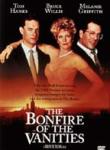 The Bonfire of the Vanities (1990), director Brian
de Palma's flop adaptation of Tom Wolfe's best-seller; mis-cast with
Tom Hanks as the central character - a Wall Street broker. The Bonfire of the Vanities (1990), director Brian
de Palma's flop adaptation of Tom Wolfe's best-seller; mis-cast with
Tom Hanks as the central character - a Wall Street broker. - Hook (1991), another high-budget film from
Steven Spielberg, was an odd and savagely-criticized updating of the Peter Pan legend. It starred Robin Williams (as Peter Pan), Dustin
Hoffman (as Captain Hook), and Julia Roberts (as Tinker Bell).
- Director Michael Lehmann's Hudson Hawk (1991) was Columbia/TriStar's ill-fated, unfunny, and poorly-executed attempt
at a heist flick (with homage to Hitchcock's To
Catch a Thief (1955) and Leslie Nielsen in The Naked Gun
(1988)). It starred Danny Aiello, Andie MacDowell, and self-indulgent
Bruce Willis in this vanity project as a reformed cat burglar who stole
priceless da Vinci art pieces around the world. The film's budget of
over $60 million brought in US box-office of only about $17 million.
- Director Renny Harlin's (star Geena Davis' husband!
and known for Cliffhanger (1993)) and MGM/Carolco's bloated Cutthroat
Island (1995) was one of the biggest flops of the decade (with an
eventual budget of $100 million and box-office of only $10 million).
The pirate movie was an adventure tale with horrible acting, a deficient
script, continuity problems, and logistical issues due to being filmed
on two continents (in Malta and Thailand). Harlin's film starred B-list
actor Matthew Modine opposite Geena Davis who was cast in the unlikely
role of Captain Morgan Adams - a swashbuckling pirate queen in search
of treasure; Carolco (makers of the Rambo series, Terminator
II: Judgment Day (1991), and Total Recall (1990)), didn't
survive after the film's failure.
- Showgirls (1995) - a sleazy, big-budget 'adult-oriented' film
that became a camp classic instead; the outlandish film was both a critical
and commercial failure, and grossed only $20 million (half of its budgeted
cost); Elizabeth Berkley (of TV's Saved By the Bell) starred
as a stripper turned Las Vegas showgirl-dancer in a soul-less, exploitative
plot with repugnant characters; the film was considered senseless, violent,
and actually sexually boring; the film was the second pairing
of director Paul Verhoeven (known for RoboCop (1987) and Basic
Instinct (1992)) and screenwriter Joe Eszterhas (also for Basic
Instinct (1992)).
 Star/director Kevin Costner's and Warners' over three-hour
long futuristic sci-fi epic The Postman (1997) with Costner in
the title role as a Shakespeare-quoting, Messiah-like postman (with
homage to the Australian Mad Max films); based on David Brin's
fantasy post-apocalyptic novel, the laughable film was budgeted at $80-100
million, with a US box-office of only about $18 million. Star/director Kevin Costner's and Warners' over three-hour
long futuristic sci-fi epic The Postman (1997) with Costner in
the title role as a Shakespeare-quoting, Messiah-like postman (with
homage to the Australian Mad Max films); based on David Brin's
fantasy post-apocalyptic novel, the laughable film was budgeted at $80-100
million, with a US box-office of only about $18 million.- Godzilla (1998) was an over-produced blockbuster
from the team of Dean Devlin and Roland Emmerich; with an unwisely-redesigned
monster-creature from the Japanese classic.
- Battlefield Earth (2000) was best known for being devoted Scientology member and spokesperson
John Travolta's greatest all-time turkey; also noted for its ridiculous
dialogue and poorly executed special effects, the unappealing film was
a miserable adaptation of L. Ron Hubbard's science-fiction novel, and
believed to be a propagandistic recruitment tool for the self-help 'religious'
Church of Scientology; the $75 million flop was released at the same
time as Ridley Scott's acclaimed Gladiator (2000).
- The tasteless, vulgar, "middle-aged
sex comedy" about marital infidelity, Town & Country (2001) failed miserably, with a budget of $85-90 million (double the original
budget), and a box-office of only about $7 million; it featured an impressive
cast: Warren Beatty and Garry Shandling as cheating husbands on their
wives Diane Keaton and Goldie Hawn. The three-year production was so
plagued with script problems and re-shoots that the studio postponed
the film's opening date 13 times!
Other Films With Critical Reviews or Failed Box-Office
Results:
- Steven Spielberg's Always (1989) starred Richard
Dreyfuss and Holly Hunter - it was a remake of the classic WWII drama
A Guy Named Joe (1943) with Spencer Tracy; it also featured Audrey
Hepburn's final screen performance as a guardian angel
- Walter Hill's cop-buddy film sequel to Eddie Murphy's
earlier box-office 1982 hit, Another 48 Hrs (1990)
- Top Gun director Tony Scott's Days of Thunder
(1990), a high-concept film described simply as "Top Gun
on wheels," starred Tom Cruise as a NASCAR stock-car racer, who
became romantically involved with hospital brain specialist (Australian
actress Nicole Kidman in her first American feature film) following
a car accident; as a result of their acquaintance on the set, the couple
were married soon after filming wrapped
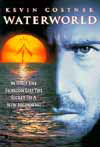 Warren
Beatty's stylish, brightly-colored but lifeless film Dick Tracy (1990)
from the Chester Gould comic-strip of the same name, with Beatty as
the title character, Madonna as blonde Breathless Mahoney, and Al Pacino
as crime boss Big Boy Caprice Warren
Beatty's stylish, brightly-colored but lifeless film Dick Tracy (1990)
from the Chester Gould comic-strip of the same name, with Beatty as
the title character, Madonna as blonde Breathless Mahoney, and Al Pacino
as crime boss Big Boy Caprice- Francis Ford Coppola's The Godfather (Part III)
(1990), the weakest film in the trilogy, and poorly cast with the
director's daughter Sofia in the crucial role as mob patriarch Michael
Corleone's (Al Pacino) daughter Mary
- Rocky V (1990), a tired and depressing fifth
(and final?) chapter of the long-running series about boxer Rocky Balboa
(Sylvester Stallone)
- Jack Nicholson's directorial debut film The Two
Jakes (1990), a convoluted sequel to the legendary Chinatown
(1974), with Nicholson reprising his role as LA detective Jake
Gittes
- further film adaptations of Larry McMurtry novels (previously
The Last Picture Show (1971) and Terms
of Endearment (1983)) failed this time at the box-office as
continuation sequels of their originals (with "Where are they now?"
plots) -- Peter Bogdanovich's Texasville (1990) and director
Robert Harling's The Evening Star (1996)
- director Robert Benton's flawed period crime drama
Billy Bathgate (1991), adapted from E.L. Doctorow's story, with
Dustin Hoffman and Nicole Kidman
- director Garry Marshall's romantic drama Frankie
and Johnny (1991), with Al Pacino and Michelle Pfeiffer cast as
co-workers in a small Greek diner
- director Russell Mulcahy's inferior fantasy sequel
Highlander II: The Quickening (1991) - both a critical and commercial
flop, with over-paid actor Sean Connery
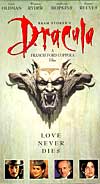 More
dubious Kevin Costner films: More
dubious Kevin Costner films:
1- director Kevin Reynolds' Robin Hood: Prince of Thieves (1991)
2- the notoriously over-extended aqua-post-apocalyptic Waterworld
(1995), infamously called "Fishtar" - although the film
ultimately broke even
3- co-writer/director Ron Shelton's sports comedy Tin Cup (1996)
with Costner as a US Open golfer who fell for psychologist Renee Russo
- Bram Stoker's Dracula (1992), also from Coppola,
another retelling of the Dracula tale with Gary Oldman as the
Count, Winona Ryder as Mina, Anthony Hopkins as the vampire slayer Van
Helsing, and Keanu Reeves as Jonathan Harker
- The Last Action Hero (1993), starring 'action
hero' Arnold Schwarzenegger failed -- even at the height of the star's
popularity!
- the awful The Avengers (1998)
adapted from the TV spy series of the same name, with Ralph Fiennes
as John Steed, and Uma Thurman as Emma Peel
- Soldier (1998), an uncompelling
outer-space version of the classic western Shane
(1953) that starred Kurt Russell, was a disaster
- aging director Woody Allen and his films in the late
1990s went mostly into decline (with lower box-office receipts and lukewarm
reviews), including: Deconstructing Harry (1997), Celebrity
(1998), Curse of the Jade Scorpion (2001), and Hollywood
Ending (2002)
- Barry Sonnenfeld's unfunny action-comedy (and sci-fi
western) Wild Wild West (1999),
although appealing for Will Smith's role and its lavish special effects,
was a money-losing revival of the classic TV series of the same name
- the expensive science-fiction thriller Red
Planet (2000) with Val Kilmer flopped miserably
- the Farrelly Brothers' unfunny Osmosis
Jones (2001) with Bill Murray was a disappointing
box-office turkey - a mixture of live-action and animation
- Disney's animated Treasure
Planet (2002), a futuristic sci-fi version
of the classic Robert L. Stevenson novel Treasure Island, was
a major flop
- Eddie Murphy's starring vehicle, the sci-fi comedy
The Adventures of Pluto Nash (2002), was a dud
- The adventure film remake of the 1939 film, The
Four Feathers (2003), was an expensive box-office bomb
Although Jim Carrey received the first of many $20 million Hollywood
salaries in the decade for his appearance in director Ben Stiller's dark,
unsettling comedy The Cable Guy (1996), the film failed miserably.
A lot of lesser horror films failed at the box office, such as the sequel
I Still Know What You Did Last Summer (1998) (scriptwriter Kevin
Williamson's original film in 1997, a follow-up to Scream, fared
slightly better) and Urban Legend (1999).
Plot Line Derivatives for 90s Hollywood Films:
To retread well-known and well-accepted plots, storylines, or film properties
from the past that would potentially provide guaranteed profits, Hollywood
studios looked to comic book characters or superheroes, sports figures,
popular TV shows or animations, or videogames for inspiration for live
action films (and their sequels), such as:
- The Rocketeer (1991)
- Super Mario Bros. (1993)
- Double Dragon (1994)
- The Flintstones (1994)
- Street Fighter (1994)
- Judge Dredd (1995)
- Mighty Morphin Power Rangers: The Movie (1995)
- Mortal Kombat (1995)
- Tank Girl (1995)
- Barb Wire (1996)
- Kazaam (1996)
- McHale's Navy (1997)
- Mr. Magoo (1997)
- Steel (1997)
- Pokemon: The First Movie (1998)
- Dudley Do-Right (1999)
- Inspector Gadget (1999)
- The Mod Squad (1999)
- My Favorite Martian (1999)
- Wild Wild West (1999)
- Wing Commander (1999)
- The Adventures of Rocky & Bullwinkle (2000)
- Dungeons & Dragons (2000)
Other examples illustrated how intellectually-bankrupt
things had become in the 1990s. Studios also refurbished old ideas with
sequels or adaptations of novels, such as:
- Return to the Blue Lagoon (1991)
- V.I. Warshawski (1991)
- Sleepwalkers (1992)
- The Scarlet Letter (1995)
- The Island of Dr. Moreau (1996)
- Kull the Conqueror (1997)
- The Rage: Carrie 2 (1999)
 Film History of the 1990s
Film History of the 1990s
Part 1, Part 2, Part 3, Part 4, Part 5, Part 6

 
|
